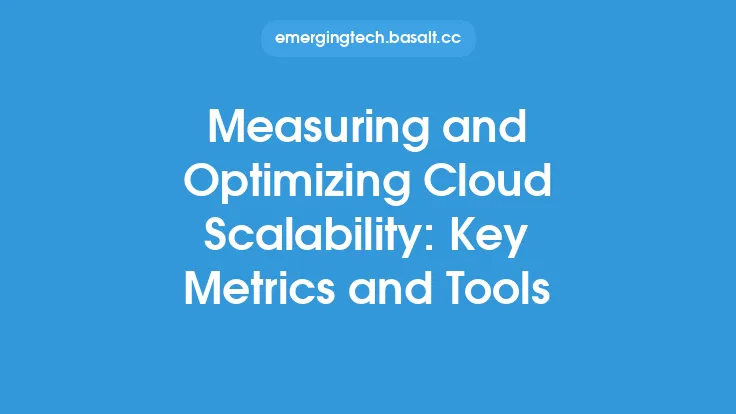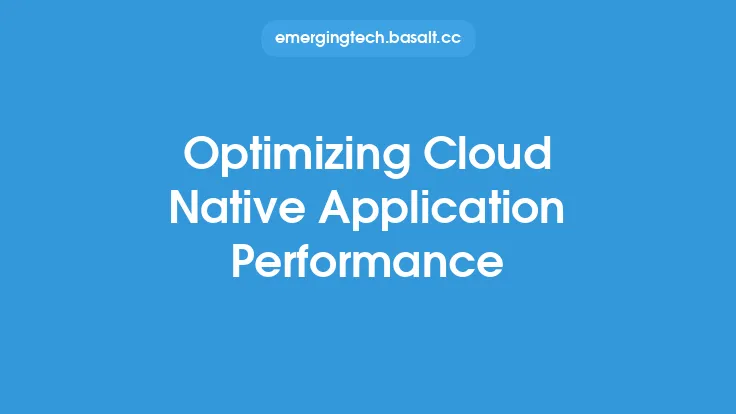When it comes to cloud scalability and performance, optimizing for high-traffic applications is crucial to ensure a seamless user experience. As more businesses move their operations to the cloud, the need for scalable and performant infrastructure has become increasingly important. In this article, we will delve into the world of cloud scalability and performance, exploring the key concepts, strategies, and best practices for optimizing high-traffic applications.
Introduction to Cloud Scalability
Cloud scalability refers to the ability of a cloud-based system to handle increased traffic, data, or user demand without compromising performance. It involves designing and configuring cloud resources to scale up or down in response to changing workload requirements. Scalability is critical for high-traffic applications, as it ensures that the system can handle sudden spikes in traffic or demand without becoming overwhelmed. Cloud providers offer a range of scalability options, including vertical scaling (increasing instance size), horizontal scaling (adding more instances), and autoscaling (automatically adjusting instance count based on demand).
Understanding Performance Optimization
Performance optimization is critical for high-traffic applications, as it directly impacts the user experience. In the context of cloud computing, performance optimization involves fine-tuning cloud resources to minimize latency, maximize throughput, and ensure efficient resource utilization. This can be achieved through various techniques, such as caching, content delivery networks (CDNs), load balancing, and database optimization. Additionally, performance optimization involves monitoring and analyzing application performance, identifying bottlenecks, and implementing targeted optimizations to improve overall system performance.
Cloud Service Models and Scalability
Cloud service models, including Infrastructure as a Service (IaaS), Platform as a Service (PaaS), and Software as a Service (SaaS), offer varying levels of scalability and performance optimization. IaaS provides the greatest level of control, allowing users to configure and manage infrastructure resources directly. PaaS offers a managed platform for deploying applications, with built-in scalability and performance optimization features. SaaS provides a fully managed software application, with scalability and performance optimization handled by the provider. Understanding the scalability and performance characteristics of each service model is essential for selecting the right cloud services for high-traffic applications.
Designing for Scalability and Performance
Designing for scalability and performance involves creating applications and systems that can efficiently handle increased traffic and demand. This requires a deep understanding of application architecture, data storage, and network infrastructure. Key design principles include loose coupling, autonomy, and asynchronous processing, which enable applications to scale more efficiently. Additionally, designers should consider data partitioning, caching, and content delivery networks to reduce latency and improve performance. By designing for scalability and performance from the outset, developers can create high-traffic applications that are optimized for cloud infrastructure.
Load Balancing and Autoscaling
Load balancing and autoscaling are critical components of cloud scalability and performance optimization. Load balancing involves distributing incoming traffic across multiple instances or resources, ensuring that no single resource becomes overwhelmed. Autoscaling involves automatically adjusting the number of instances or resources based on changing demand, ensuring that the system can handle sudden spikes in traffic. By combining load balancing and autoscaling, developers can create highly scalable and performant systems that can handle high-traffic applications with ease.
Database Optimization for Scalability
Database optimization is essential for high-traffic applications, as databases are often the bottleneck in scalable systems. Techniques such as indexing, caching, and connection pooling can significantly improve database performance. Additionally, designers should consider database replication, sharding, and partitioning to distribute data and reduce latency. By optimizing databases for scalability, developers can create high-traffic applications that can handle large volumes of data and user requests.
Network Optimization for Performance
Network optimization is critical for high-traffic applications, as network latency can significantly impact user experience. Techniques such as content delivery networks (CDNs), edge computing, and network caching can reduce latency and improve performance. Additionally, designers should consider network architecture, including load balancing, firewalls, and virtual private networks (VPNs), to ensure secure and efficient data transfer. By optimizing networks for performance, developers can create high-traffic applications that can handle large volumes of data and user requests.
Security and Compliance in Scalable Systems
Security and compliance are essential considerations for high-traffic applications, as scalable systems can introduce new security risks. Designers should consider security principles such as confidentiality, integrity, and availability, and implement measures such as encryption, access control, and monitoring to ensure secure data transfer and storage. Additionally, developers should ensure compliance with relevant regulations and standards, such as GDPR, HIPAA, and PCI-DSS, to avoid legal and reputational risks. By prioritizing security and compliance, developers can create high-traffic applications that are both scalable and secure.
Monitoring and Analytics for Scalability
Monitoring and analytics are critical for optimizing scalability and performance in high-traffic applications. By monitoring key metrics such as latency, throughput, and error rates, developers can identify bottlenecks and areas for optimization. Analytics tools can provide insights into user behavior, application performance, and system utilization, enabling targeted optimizations to improve overall system performance. By leveraging monitoring and analytics, developers can create high-traffic applications that are optimized for cloud infrastructure and provide a seamless user experience.
Best Practices for Scalability and Performance
Best practices for scalability and performance involve a combination of design principles, technical techniques, and operational strategies. Key best practices include designing for scalability and performance from the outset, using cloud-native services and architectures, and implementing load balancing, autoscaling, and database optimization. Additionally, developers should prioritize security and compliance, monitor and analyze application performance, and implement continuous integration and delivery (CI/CD) pipelines to ensure rapid deployment and iteration. By following these best practices, developers can create high-traffic applications that are optimized for cloud infrastructure and provide a seamless user experience.





